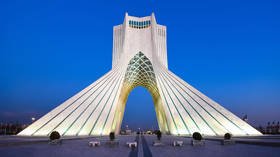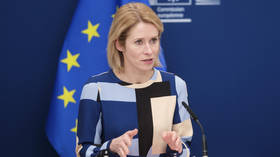Iran is winning strategic struggle for influence, even as US cripples its economy

A new report has confirmed what some analysts have been saying for some time: that Iran is winning the regional struggle for strategic influence.
The 217-page report, published by the London-based International Institute for Strategic Studies (IISS), is entitled “Iran’s Networks of Influence in the Middle East” and details Tehran’s use of proxy forces and networks throughout the region and the effects and benefits of its “minimum output” foreign policy strategy.
It is probably worth mentioning at this point that H.R. McMaster, Trump’s former national security adviser, was once an employee of the IISS. As was James Steinberg, a former US deputy secretary of state. Furthermore, at the end of 2016, the Guardian revealed that the organization had received £25 million ($32 million) from the Bahraini royal family (apparently almost half of its total income has come from Bahrain). Iran and Bahrain aren’t exactly close friends.
Notwithstanding the potential motives and bias of the IISS, the report definitely arrives at some interesting conclusions.
“The Islamic Republic of Iran has tipped the balance of effective force in the Middle East in its favor,” the report explains.
Also on rt.com China – not Iran – is the real reason US troops will never leave IraqBut here’s the crazy part. Iran is, and has been for years, completely pummeled to the ground by US-imposed sanctions. Many commentators have for some time now been predicting an impending collapse of the Iranian economy.
On top of that, and likely because of this fact, Iran’s military budget has consistently been low (especially when compared to the United States or any of Washington’s major allied powers in the region). This flies completely in the face of allegations that Iran is a regional aggressor and the number-one state sponsor of terrorism (with what money?), but don’t let this get in the way of a good story.
According to the US Defense Department’s annual review of the country, “Iran’s military doctrine is defensive. It is designed to deter an attack, survive an initial strike, retaliate against an aggressor, and force a diplomatic solution to hostilities while avoiding any concessions that challenge its core interests.”
In other words, despite being under the constant threat of war, whether from the US, Israel or Saudi Arabia, Iran is not looking for a fight. It maintains a much lower military expenditure than Saudi Arabia, Israel, and especially Washington, yet as the recent IISS report notes, it has emerged from the rubble of a war-torn Middle East region as a victor.
As Foreign Affairs (the Council on Foreign Relations’ magazine) explained in a recent article:
“Iran now enters its second year under maximum pressure strikingly confident in its economic stability and regional position.”
Also on rt.com As PM Hariri resigns and Lebanon faces a power vacuum, maybe it is time to reassess relations with the USIt is likely with this newfound confidence that Iran is beginning to dictate some shots of its own to the international community, particularly when it comes to the future of uranium enrichment. Foreign Affairs also explains that Iran has essentially weathered the storm of US sanctions and come up trumps all on its lonesome. Many of the people predicted to come to Tehran’s aid during the United States’ maximum pressure campaign have been nowhere to be seen.
According to the IISS report, Iran has been winning the regional geopolitical struggle for influence by developing asymmetric warfare, such as swarm tactics, drones and cyber-attacks. It has relied upon the Quds arm of the Islamic Revolutionary Guard Corps (IRGC) to increase its operations throughout the Middle East, as well as to provide training, support and weapons to other actors allied to Tehran. The report also notes Iran’s relationship with Hezbollah, its role in the conflicts in Iraq and Syria, as well as its role (supposedly) in Yemen.
As my Kung Fu instructor once told me, you serve yourself in a confrontation best by using minimum output for maximum gain. Winning the lottery doesn’t entail that you then go to a casino and put all your money down on your first gamble. Just because you have it, doesn’t mean you have to expend it.
In comparison, Saudi Arabia has expended time, effort, billions of dollars and the lives of many innocent civilians waging a genocidal war in Yemen – and it’s still losing. As Bloomberg once explained:
“Saudi Arabia has better weapons than its enemies in Yemen, no surprise in a war that pits one of the richest Arab countries against the poorest. And still the Saudis are struggling to impose their will.”
Not only is it losing a war, it’s also losing an economic battle. At the beginning of the conflict, Reuters estimated that the war would cost Saudi Arabia approximately $175 million per month. However, even by the end of the first year of the war, the kingdom had to increase its defense spending by $5.3 billion. This trend has continued right throughout the conflict. At the end of 2016, Saudi Arabia had to announce a projected increase of 6.7 percent in defense spending for 2017, bringing its total budget to around $50.8 billion.
Also on rt.com Leaked footage shows US weapons transfer to Saudi-led coalition in Yemen as arms are doled out to jihadists – reportIf the IISS report’s findings are correct, there may be a deep lesson in here for the US and its allies. Perhaps it’s not that Iran has emerged victorious despite the fact it has not spent billions of dollars invading other nations at any one time; but because it hasn’t been.
At the end of the day, how much influence can you exert when you forcibly invade, occupy and kill those countries you seek to influence?
Think your friends would be interested? Share this story!
The statements, views and opinions expressed in this column are solely those of the author and do not necessarily represent those of RT.














